Local positioning is a series of optimization activities designed to increase the visibility of local businesses in the search engine. If you run a stationary store, service establishment or offer service in a particular area, your customers will search for you using local keywords such as “hairdresser Krakow” or “SEO Warsaw”. How to get found? In the following article, we will tell you how the local SEO algorithm works and how to optimize your site to be more visible. We invite you to join us!
What is local search?
.
Local search is queries for services performed in a particular area: city, neighborhood or region. They can refer to catering, various types of beauty industry services, repair services, and IT and marketing industries. If you don’t know if your industry is local, check the search engine for the keywords you’d like your site to show up for and see what the results are in SERP. If the search engine shows businesses in your area and map, then you need to take care of your local SEO!
According to statistics provided by WebFX, up to 46% of Google searches are for local queries. Searches for the phrases “near me”/”near me” have also increased by almost 500% over the past few years! Despite the significant growth of the local search trend, as many as 56% of entrepreneurs do not have a business card in Google My Business. If you’re among this group, it’s worth catching up as soon as possible.
If you need more data to convince yourself of the validity of local SEO, keep in mind that as many as 76% of people who search for businesses near them visit them within the next day. Taking care of local SEO is therefore a huge opportunity to be visible – both online and offline.
SERP results by location
.
How do we search to find the services that interest us most at the moment? The most popular way is to search using local phrases, such as “hairdresser Krakow”, “coffee shop Market Square” or “plumber Nowa Huta”. You can also adjust your search engine settings and narrow your search to a particular region.
However, it is worth noting that Google’s algorithm is smart enough to know for which industries users expect results located close to them, even if they do not use additional settings in the search engine. Thus, typing the query “gym”, “hotel” or “library” into the search engine will yield results in our immediate area based on location.
The greater the competition in a given area, the smaller the search radius Google will show. For example, if we are standing in the Market Square in Krakow looking for a coffee shop, Google will show us a really small area, limiting us to the Market Square itself and a few of the nearest streets. However, standing in the same place and searching for less competitive services, we will get results from, for example, the entire city or district. When running a local business, it is therefore worth checking how much competition we have around us and whether it will be necessary to intensify local positioning for small businesses.
How do local results look like?
.
By typing in search queries for services near us, we will get results that consist of:
- results on directories and social media
- maps
- local results
.
.
.
The most desirable results are those on maps that display above organic results. This is the so-called local pack, which shows the three most relevant results from our immediate area. Already from the search engine, we can find out a lot of information that will help us decide whether to visit a particular spot. In addition to the company name, address and phone number, opening hours and ratings are displayed. A remarkable convenience, especially on mobile devices, is the “Route” button, which immediately takes us to Google Maps, from where we can navigate to our chosen destination.
Algorithm of local SEO
.
In traditional SEO, Google takes into account on-site and off-site factors to determine the position of phrases. The local SEO algorithm is based on similar factors, but the weighting of the signals in question is slightly different. What’s more, the importance of the signals also differs between determining positions in the so-called local pack, or map results, and in local organic results.
According to data from Semrush Academy, for determining local pack results, the most important ranking factors are:
- Signs from your Google My Business (Google business card) profile. Ensure that all information on your profile is completed and keep it updated. Add photos, answer user questions and encourage customers to leave feedback.
- External linking from local portals. Just as in traditional SEO, external links leading to a site prove its popularity. In local SEO, it is important that links come from local sites. These can be both news sites and those belonging to local institutions, sports clubs or interest groups. It’s worth checking whether we can support a local activity with our business in exchange for placing a link on their site.
- Reviews and feedback. According to WebFX, up to 91% of users trust businesses with positive reviews. Remember that both quantity and quality of reviews are important. It is also a good practice to respond to all reviews posted by users, both bad and good. Don’t worry about a few negative reviews either – a small number of them looks natural.
- Optimize on-page. Take care of all the basic elements of on-page optimization for SEO, such as title and description optimization, Hx header structure and keyword placement in the content.
- Citations, or mentions in NAP directories. Listing in NAP (name – address – phone) directories increases your visibility, as well as makes your business more credible, both in the eyes of the user and the search engine. Be sure to check that you list the same contact information, i.e. address and company name, in all places.
- Behavioral signals, i.e. the behavior of real users, are extremely important and Google is increasingly taking them into account. This ranges from engagement on the Google My Business profile, checking in at a location and so-called pogo sticking, which is when a user clicks on a particular result in the SERP and then quickly returns to the search results page. This usually means that he didn’t find what he was looking for on a particular page. If the situation persists, Google will start showing a better site in its place, where users find all the information without any problems.
- Personalization of search results, i.e. the influence of previously searched pages, is of very minor importance, but it also affects the results you get when searching.
- Signals from social media are of marginal importance for local search positioning. However, this does not mean that you should abandon your business profile on Facebook or other sites, as social media is extremely important in terms of customer service.
.
.
.
.
.
.
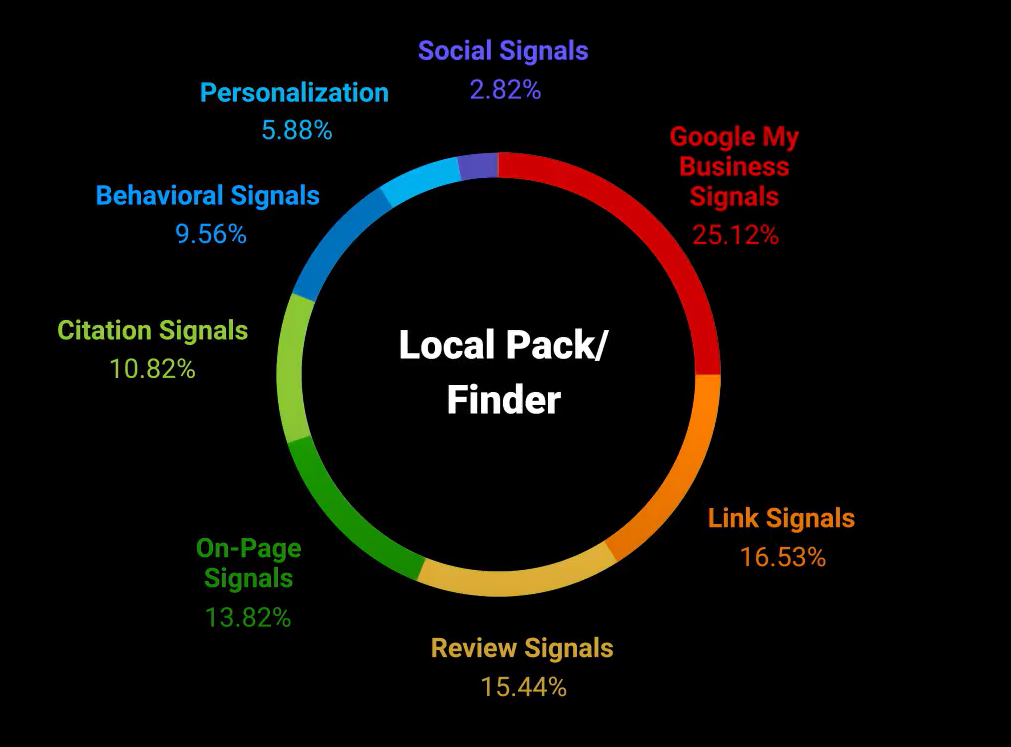
The same ranking factors are important in determining position in localized organic results, but may have different weight and importance than in map results.
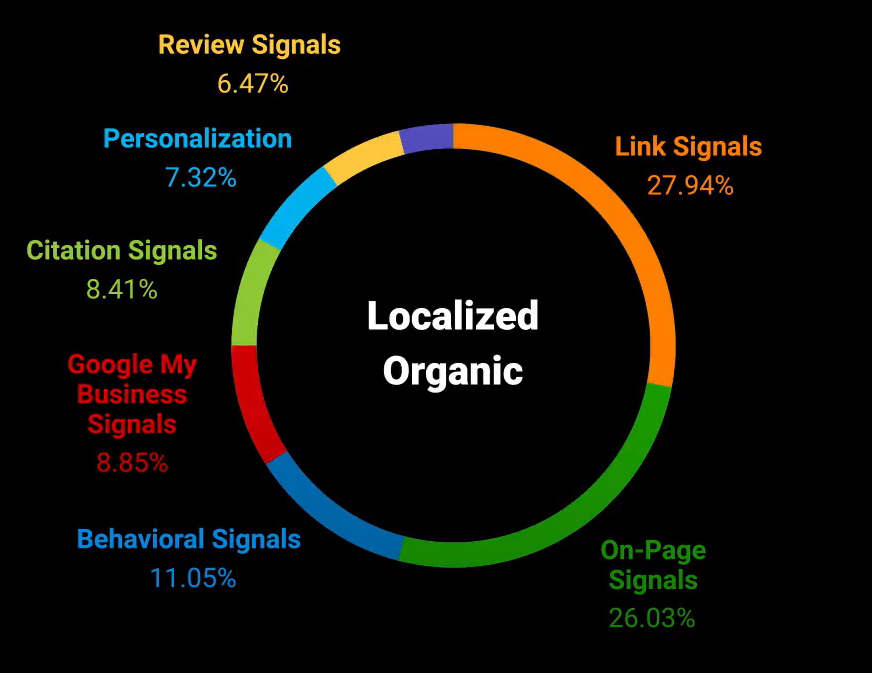
Local keyword search
.
As in traditional SEO,one of the most important factors affecting a site’s visibility is keywords, which are the phrases that users type in to find something in a search engine. Proper optimization for phrases is fundamental so that Google’s robots, after indexing the site, know what user queries to display it for.
Local phrases that users type into Google are most often the name of the service + the city, i.e. fryer Cracow, dentist Warsaw, carpet washing Łódź. For larger cities, where there is a lot of competition, you can also narrow your search area to, for example, a particular neighborhood, such as cafe Praga Północ Warsaw. It’s worth remembering that for some queries, Google returns local results even if you don’t specify the area.
Research the first page of Google results
.
Before starting your optimization efforts, you should conduct a keyword analysis.
The first step is to see if our industry is local and what results are returned for the phrases we are interested in. Let’s assume that we run an artisan bakery in Krakow and our main phrase will be “bakery Krakow”. Let’s analyze what the first page of results in Google looks like.
It contains such elements as:
- directory entries and social media links
- a map of the area with points of interest
- the top three scores
.
.
.
It’s worth checking out what’s below in the organic results as well. Are they competitors’ sites, industry-related articles, or rankings, for example?
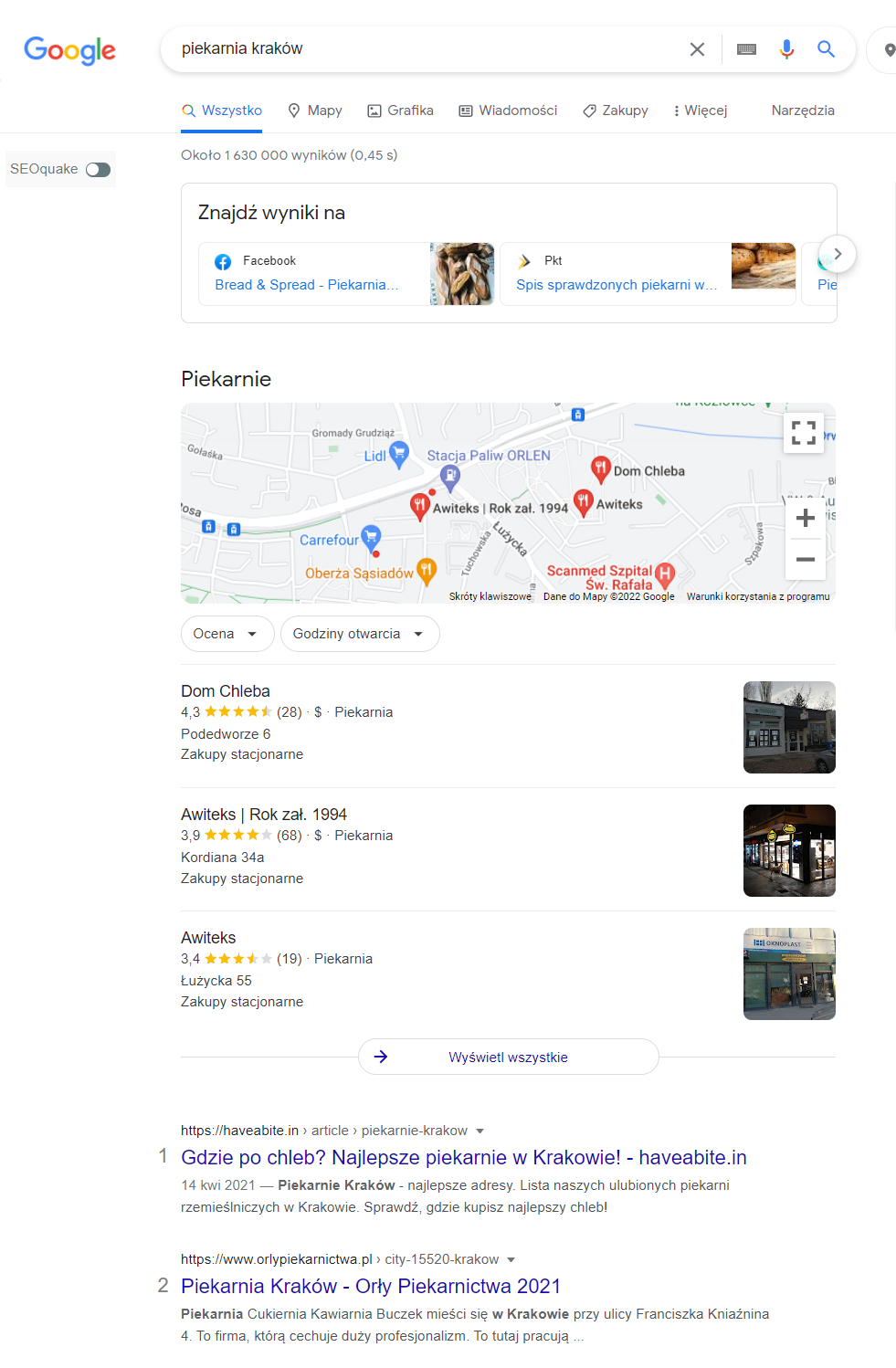
Insights from the first page of search results give a lot of information about how Google promotes a particular industry and what elements (directory listings, Google My Business card) should be taken care of.
Identify local keywords
.
The next step is a detailed keyword analysis. For this, tools such as Senuto, Ahrefs or Google’s Keyword Planner will be useful. Each of these tools works similarly – in the keyword databases, you type in the phrase you are interested in and get results with phrase suggestions and information on the average monthly number of searches.
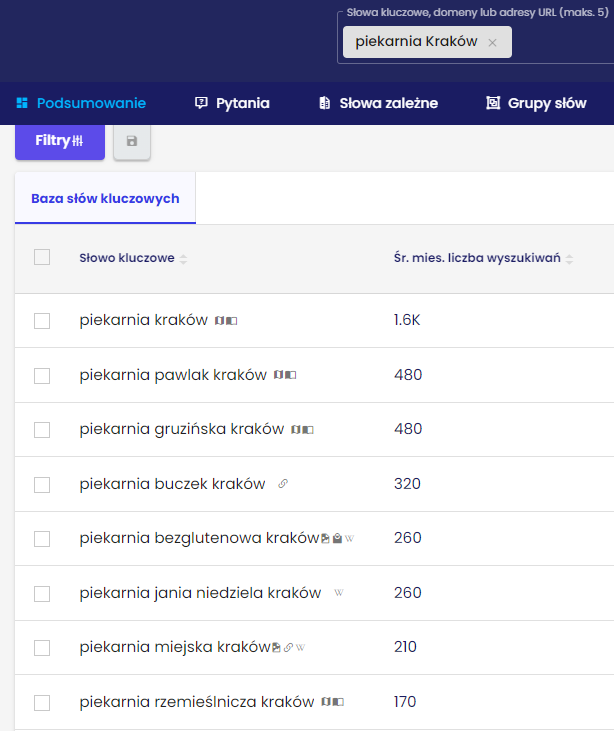
In addition, the search engine itself can also be a source of phrase ideas! In Google’s hints, we can find additional phrases typed in by users who are looking for bakeries in Krakow.
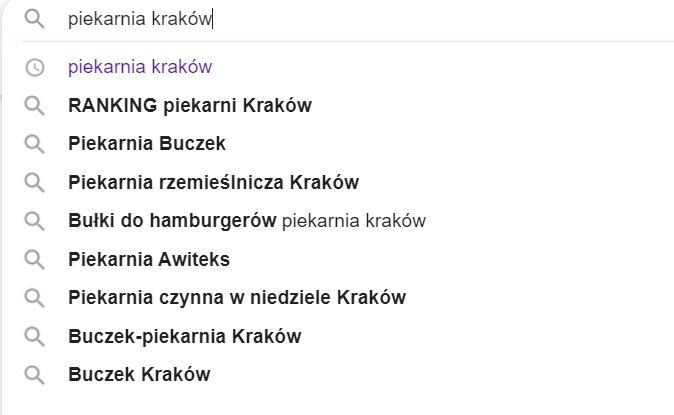
Keyword analysis will create a list of phrases that should be included on the page in the service description, title, meta description and headings.
Find your competitors’ local keywords
.
Where else can you look for keywords for your site? A great source of information is your competitors! After reviewing the first page of search results for the phrases we are interested in, we are able to isolate our closest competitors. In the case of local SEO, this is competition both online and in real life, as we compete for users’ attention in these two spheres.
How do we extract our competitors’ keywords? Senuto and Ahrefs tool will be helpful here. After entering our competitor’s address into Visibility Analysis in Senuto, we get a list of the key phrases the site displays for, along with the search engine position and estimated traffic:
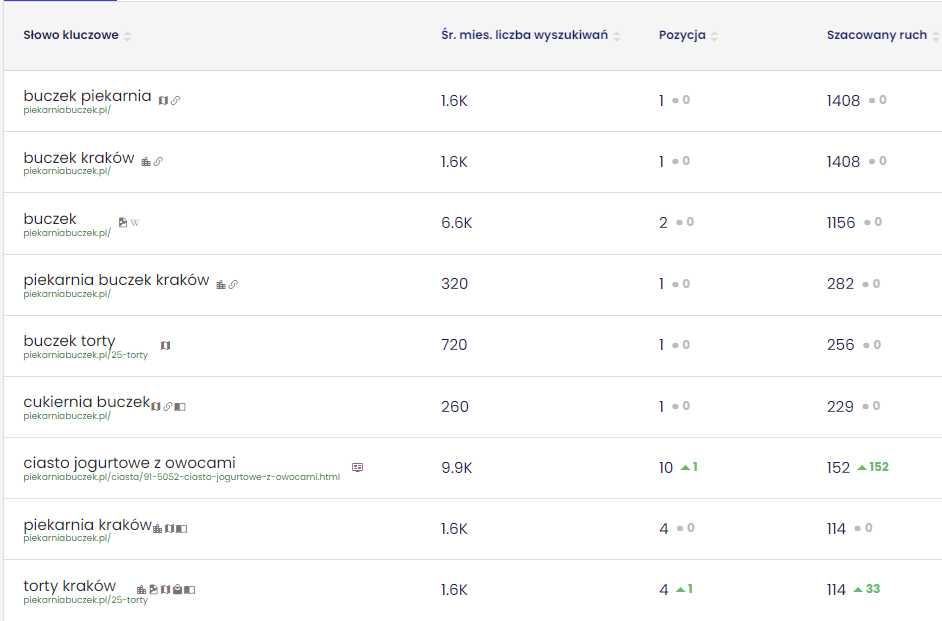 .
.
You will get similar results by checking the site in Ahrefs → Organic keywords.
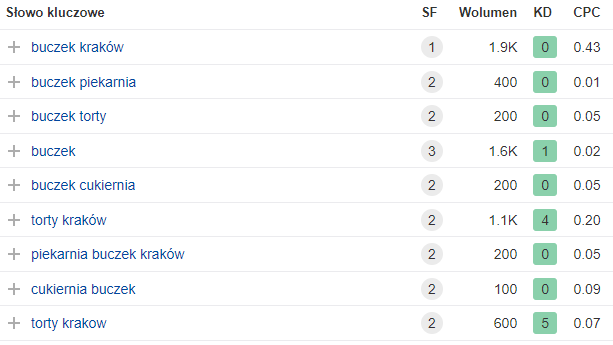
In both tools we have the ability to see what keywords our competitors are displaying for, and our site is not yet. In Senuto, in the Visibility Analysis module, we select Tools and then Competitor Analysis. We enter our domain and our competitor’s domain and get an analysis of the missing keywords that we should consider adding to our SEO campaign.
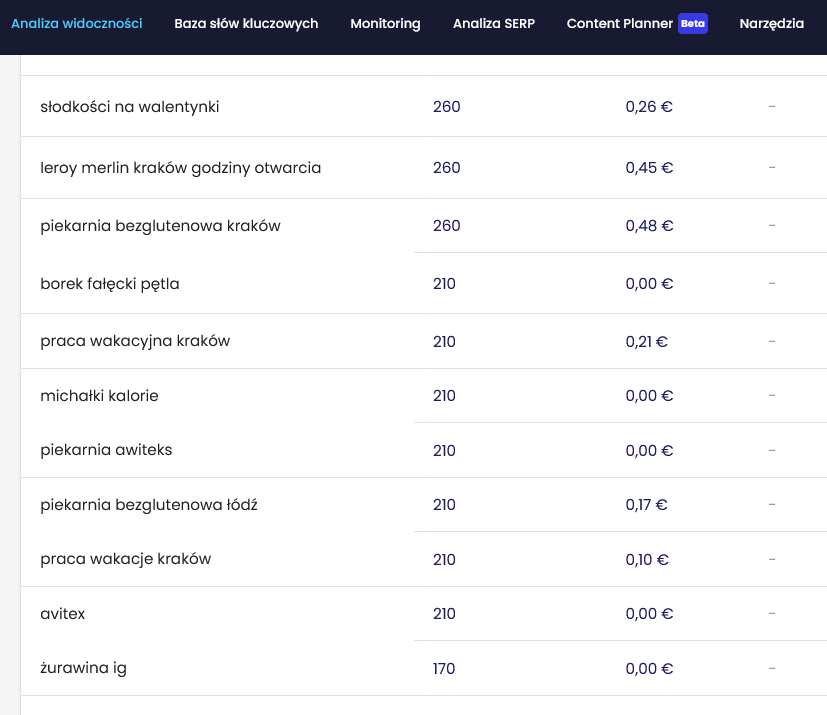
Of course, verifying the words of the competition, you must take into account that, to a large extent, these may be branded phrases , containing the brand name. So we focus only on general and local phrases that we can add to our site.
Google My Business
.
An extremely important element of local positioning is a profile in Google Moja Firma. Business cards are usually displayed to the right of the search results, and in addition, summary information is included in the local pack, the top three results in the maps.
Experts agree that when it comes to local SEO, a business card in Google Moja Firma should be treated the same as a website’s home page. The interaction with the profile in GMF is usually the user’s first contact with our company, and they can learn a lot of information from it that will help them decide whether to use our services.
When setting up a Google My Business card, you need to confirm your location. There are several ways to authenticate it, such as entering a special code that will come to us by traditional mail to the address indicated. Very important when optimizing a business card is to specify the address or area of the services performed. This is important depending on the industry: if you run a coffee shop that customers can visit on site – give the exact address. And if you provide service throughout the city, you can indicate the area in which you work.
Google My Business card is a goldmine of information about our company. In addition to the address, opening hours, contact number and website link, you can include a brief description of the company, as well as photos, posts and information about events or discounts. GMF posts, which consist of a photo and a short description, disappear after a week from the main business card page, so it is worth ensuring that they are published regularly so that they are visible all the time.
The photos that are on the business card can be included by us as owners, but also by our customers. It can be a good idea to have a professional photo shoot to be able to present the headquarters and products in an attractive way.
One of the most important elements of a business card is user reviews. As we wrote earlier, it is worth encouraging customers to give reviews. Every review should also be answered – whether it is positive or negative.
The multitude of elements and opportunities provided by the Google My Company business card are worth taking advantage of in order to best present your company and encourage users to interact with the business card itself. Signals from your business card are an important ranking factor, especially when determining your position in the local pack, the three featured results on the maps.
Local SEO – what to improve on the site?
.
Make a landing page for each location
.
Depending on how fragmented the structure of our business is – i.e. how many stationary locations we provide services or sell products in, or what geographic area we cover with our operations – we should also take this into account in the actual construction of the page representing us online.
By this, of course, we meancreation of dedicated sub-pages for given locations. Let’s point out right away, however, that this should be based on data on the potential of related phrases. Creating dozens or hundreds of landing pages just to cover the largest and most specific geographic area possible can consequently generate problems with thin content and duplication of content within the overall site.
Where to start
.
The first step should beanalyzing what our company’s area of operation actually is. If we operate nationwide and only have one branch each in major cities across the country, we should rather focus on expanding the website structure precisely with a landing page regarding the scope of our business in those urban centers.
The above point is mainly applicable to companies with extensive infrastructure throughout the country, for which having a branch in a particular city is not unusual. It is also worth noting that this usually applies to businesses that deal with the sale of physical products. Take the furniture industry as an example – it’s rare that a specification deeper than a city makes more sense:
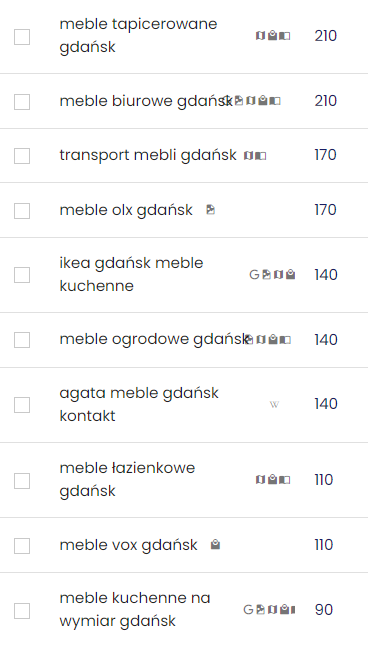 .
.
If our branding is recognizable and we have only one outlet in a particular city, we only need to create dedicated subpages for this type of immersion according to the formula:

Of course, if you have more establishments in a given city, you should consider creating (and indexing) subpages with greater territorial refinement. Keep in mind that such a procedure should be carried out based on search volume data for phrases of increasing refinement..
As we mentioned earlier, this type of subdivision is used most often when, as a company, we offer online sales of products and want to give the user additional information about the existence of physical stores offering them.
Obviously, in such a case we limit ourselves to creating a landing page being information about the existence of our establishment in a given location, we do not copy the entire structure of the online store, which will differ from its original only by phrases taking into account a given city or area.
An interesting case of splitting page structure for local SEO “limited” to cities are domains of universities. If they have outposts in different cities and the educational offerings vary by location, they choose to create dedicated sections for branches along with separate subpages for the curriculum in a particular city. This is a special case, since the structure of the page is then determined by the range of services offered at a specific location. Landing pages thus serve the purpose of both attracting regional traffic to the site and basic communication with the potential student, not limited to issues related to improving local SEO.
When does it make sense to further deepen the site structure with another local landing page?
Above we touched on including city-dedicated landing pages in the site structure, but what about when you want further refinement, such as to the neighborhoods in question (and it makes sense based on the data)?
Such a case applies mostly to companies moving in the service sector. If our business operates in a given metropolitan area, but has several/some outlets in different districts, it is worth using the full potential of key phrases. An example breakdown of the structure ( in a gross simplification) will then be as follows:
 .
.
Of course, if the range of services offered to customers depends on the location, it is also worth taking this into account in the further development of the structure. For example, if you have a network of medical offices and operate in different neighborhoods and offer different treatments depending on the location, you should create landings on a per-location basis:
[Treatment Name] [District Name] [City] [Brand].
Such a division will allow us to reach a potential customer faster and more precisely.
Above we mentioned local positioning for a small business, but all kinds of bid aggregators also benefit from this kind of refinement:
 .
.
This type of action not only supports positioning, but is also geared towards user comfort. He quickly gets feedback on his refined query and is not forced to painstakingly search through the entire resources of the site.
Optimize your homepage
.
The home page of a website is usually the strongest in terms of URL rating, number of links leading to it and other parameters. It is also the most representative of our company. So make sure that the content on it supports local positioning. If you are positioning a small, local company that operates in a specific location it is worthwhile for you to include such information already in the title attribute of the homepage – for example:
If you run a restaurant in Warsaw’s Mokotow district, which specializes in Polish cuisine, it’s worth considering inserting in the title attribute of the home page:
Polish cuisine Warsaw Mokotow | [Restaurant name].
Also, the content on the page should indicate the location of the restaurant. However, remember to include phrases in a natural way that follows the language rules – i.e. instead of “Check out our Polish cuisine Warsaw Mokotow”, include text like “Our restaurant located in Warsaw Mokotow specializes in Polish cuisine”.
The home page should contain the most important information about our company and the geographic area in which it operates.
Add Schema tag
.
Structured data are tags in the page code that allow you to label and define what the text elements are and what type of information they contain. They allow you to add additional information that can be read by search engine algorithms.
For businesses operating locally, it is a good idea to implement Schema.org tags assigned to local businesses, i.e. LocalBusiness – https://schema.org/LocalBusiness.
In this subgroup you will find tags for information such as:
- Business name – name
- Physical address – PostalAddress
- Geographic coordinates of the company – GeoCoordinates
- Opening hours – OpeningHoursSpecification
- Company branch – department
.
.
.
.
.
Thanks to the tags, it is also possible to specify more precisely the area of activity of our company – in the Schema documentation we can find tags for example:
- Dental office – Dentist
- Restaurant – Restaurant
- Travel agency – TravelAgency
- Real estate brokerage agent – RealEstateAgent
- Store – Store
.
.
.
.
.
Many of the designations listed have further refinements – we can, among other things, specify what kind of store we run, etc.
Tag implementation methods are described, for example, on Google for Developers.
Linkbuilding vs. local positioning
.
The approach to link acquisition for local activities is counterintuitively different from the typical linkbuilding campaign for sites that operate on a larger scale. After all, we’re talking about gaining links for activities confined to a smaller area. When we usually focus on link acquisition, taking into account various parameters such as ahrefs DR, DA, or Trust Flow and Citation Flow from Majestic, in the case of linkbuilding for local SEO, we should pay special attention rather to the local match of the sites.
As a rule, local portals or any link acquisition sources of this nature are characterized by a lower value of the aforementioned parameters. This is due to the fact that there are fewer external links to these types of sites, they do not have such an extensive structure as national sites. Thus, their usefulness in a broader SEO campaign would be low, but for local activities they show high effectiveness. It seems that Google just takes into account the “territorial” linking of such links in such a case.
The theory is that in actions for regional businesses, nofollow links can also realistically contribute to improving search engine rankings. Acquiring links of this type can be simpler and much cheaper if you operate in the local community and decide to support some initiative that obviously has a website. Then it is worth asking for a link directing to our site in return.
As you can see, in activities focused on the positioning of a small local company’s website, it is not worthwhile to be guided only by the parameters obtained from the tools. It is also necessary to take into account the “local” convergence of the portal from which we want to obtain a link with our domain.
Track changes in the position of local phrases
.
How to track local positioning statistics? Of course, it’s a good idea to check in the Google Search Console, as a standard, which phrases users have gone to the site from. The tool from Google will also tell you the position of a phrase and how it has changed over time.
To control the visibility of the site for local phrases, it is also worth using various search engine position monitoring tools, nowadays a large part of them have the ability to select the location from which the keyword is to be checked (including the Senuto Monitoring module). The possibility of such narrowing is important, because Google even for seemingly general words, such as “hairdresser”, “pizzeria” will show us completely different results, tailored to the place from which the search took place:


Summary
.
The local SEO algorithm is slightly different from the one that determines organic search results for non-location-related queries. However, what is important remains the same: technical optimization of the site, adding keywords to the content and title and description, and linkbuilding. It’s worth remembering the elements typical of local SEO, such as adding Schema to tag elements on the page, or keeping your Google My Business card up-to-date. To be successful in local SEO, it is also important to keep an eye on the competition and see what activities are successful in your industry.
 Alicja Stojek
Alicja Stojek